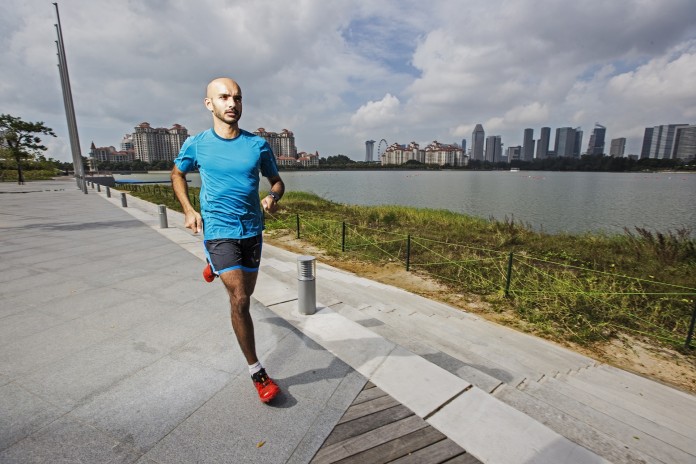JRL: What have you learnt about yourself from running in ultramarathons?
Paviter: I’ve learnt a lot. I’ve learnt to become more patient and to manage my own expectations about myself and others. I think it’s made me a bit less temperamental; I don’t get overexcited about things as much as before because ultra-running has taught me it’s about thinking long-term and not short-term.
I’ve learnt to appreciate the value of people around me. There was this one particular instance, it was the first time I was running the TNF Australia, and I was struggling quite a bit at 65km. My IT band was flaring up and someone just ran past me, I had no idea who she was, but she said “you’re struggling what’s going on?” and I said “my IT band is flaring up”. She was a physiotherapist, and she said “sit down, let me sort you out” and she strapped my knee up and off she went. I never got to speak to her again, but it’s that sense of camaraderie, understanding, and people helping each other in moments of need, that really struck a chord in me, because that’s what ultra-running really is about.
It gives you back some faith in humanity, and I definitely feel more human because of it. Some of the stories I hear of why people do ultra-running is also quite moving. There was this guy in a race whose leg was broken, and he knew it was broken but he still ran 100km to raise the funds for his child suffering from cerebral palsy. Stories like that move me so much.
JRL: That’s one of the common reasons people run in races, to raise funds and awareness for charity, such as the Wings for life, where you’ll be representing Singapore in Taiwan. Tell us a little about the race.
Paviter: So it’s a global event across 35 countries, to raise funds for spinal cord injury research. I’m leaving Singapore on 2nd May, and I’ll be running in Yilan on 3rd May at 7pm. It’s the first time I’m running this race, so it’s pretty exciting. Red Bull Singapore has been really supportive of me doing this race, and it’s nice to be a part of this race, since I truly believe in the cause. So many people are affected by spinal cord injuries, and they can’t run. Imagine how painful that would be, so for me, this race means a lot.
JRL: Can you describe a bit about how this run actually works?
Paviter: The run kicks off simultaneously across 35 countries. For people living in the USA, it’d be about 3am in the morning, which is hard luck, so I’m quite lucky to be in Asia for that! Half an hour into the race, a chaser car will start off at a fairly slow speed and as the race continues, it will pick up speed. When the chaser car passes someone, that’s the end of the race for that person. There is no finish line – the finish line is the chaser car.
It is a marked course, with checkpoints at every 5km, where there will be hydration points so it’s really well organised. Each city’s course route is available online on the official website. The race will also be streamed live.
JRL: What are your primary goals for this event?
Paviter: Primarily, it’s to put Singapore on the map, as I think I’m the only Singaporean running in Taiwan.
The second objective is to meet as many people who have been affected by spinal cord injury as possible before the race, because ultimately, this race is for them. It’s not a race for the runners, it’s a race for the people who can’t run. During the race, I’ll just do what I can to stay ahead of the chaser cars! It’s like playing hide and seek but you can’t hide, the chaser cars know where you are!
JRL: What do you foresee to be your biggest challenges at this event?
Paviter: I think my biggest challenge is maintaining a good and strong pace on tarmac. I’m used to long endurance races with hills, dips, and changes in pace, which is why I’ve had to alter my training a little bit in the past month just to get used to maintaining a constant pace.
JRL: Describe your average week during training for this event.
Paviter: I work with a coach from Mile27, his name is Andy DuBois. He’s been my coach for close to 2 years now and he’s helped me a lot, especially in specific training. My training week includes a 30min tempo run, with 30-60min hill repeats sprints, a 4-6km at an easy pace with my running club, a hard session of speed training, 60mins easy, a long run and 90 minutes of stair-training. So that’s a snapshot of an average week of my general training.
To prepare for Wings for Life, I’m replacing my hill training with progressive speed training for 90 minutes, which comes to a half-marathon distance.
JRL: What advice would you give to runners contemplating ultramarathon distances?
Paviter: I feel that ultramarathon running is the most accessible sport in the world. I think anyone can do it. It’s more mental than physical; I’ve seen 80-year-olds doing it. The aim is not to think about the distance. Think instead about the journey, and what you learn from it. It’s not about speed at all. It’s about understanding yourself, it’s about pushing through boundaries.
That’s a mentality applicable to life in general as well – what’s the hurry? Take a step back, listen to people around you, and then make a decision. What I’ve learnt from ultra-running, I’ve applied to other areas of my life and work as I see lots of parallels.




